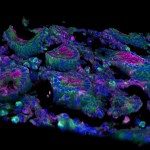Lien vers Pubmed [PMID] – 24598230
J. Virol. Methods 2014 Jun;202:46-53
Droplet Digital PCR (ddPCR) represents a new and alternative platform to conventional quantitative-PCR (qPCR) for the quantitation of DNA templates. However, the proposed improvement in sensitivity and reproducibility offered by ddPCR is not yet fully proven, partly because the delineation between positive and negative responses is not always clear. Data are presented demonstrating the sensitivity of the ddPCR system to both reagent concentrations and choice of cut-off for defining positive and negative results. By implementing k-nearest clustering, cut-offs are produced that improve the accuracy of ddPCR where target DNA is present at low copy numbers, a key application of ddPCR. This approach is applied to human albumin and HIV-1 proviral DNA ddPCR quantitative protocols. This tool is coded in JavaScript and has been made available for free in a web browser at http://www.definetherain.org.uk. Optimisation of the analyses of raw ddPCR data using ‘definetherain’ indicates that low target number detection can be improved by its implementation. Further application to patient samples will help define the clinical utility of this approach.
